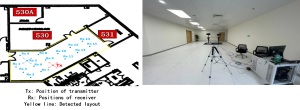From Algorithms and Devices to Systems
Stochastic Optimization
My main research vision is to establish an efficient and general algorithm design framework via Markov Decision Process (MDP), such that the scope of algorithm design for wireless and computing resource allocation can be extended. MDP is a powerful tool for the optimization along a sequence of time slots (stages), where an average total cost is minimized. However, its applications in wireless systems or computing systems usually suffer from the curse of dimensionality. For instance, the key to solve an MDP problem is to evaluate its value function for all possible system states, and the number of system states usually grow exponentially with respect to the number of users in the system. Current approximate approaches, like deep reinforcement learning, is general for the MDP applications in almost all areas. They do not exploit the well-formulated structure of the communication or computing systems. Hence, it is of great interests to design more efficient and insightful solution algorithms for MDP in communication or computing systems.
My first attempt in this direction is to propose a decomposition method for value function such that it can be approximated as a linear combination of local value functions. It reduces the exponential computation complexity and memory requirement to linear, and also facilitate semi-distributive scheduler design. This approach can be widely applied in delay-aware scheduling of wireless networks and computing systems. However, the local value functions have no analytical expressions, and have to be evaluated via iterative algorithm.
Hence, my follow-up attempt is to develop analytical approximation method for value function, whose gaps to the true value function or performance gap to the optimal solution can be bounded tightly. My latest progress demonstrates its feasibility. To date, I have developed methods with analytical approximate value function for the optimization with infinite or random number of stages. The application scenarios include: (1) joint popular file placement and deliver in a cache-enabled cellular network; (2) downlink video streaming in massive MIMO networks; (3) mobile-edge computing systems. None of the above demonstration scenarios can be addressed via the existing methods, as some practical considerations are included. For example, in the first scenario, I address the resource allocation with finite file lifetime. In the following two scenarios, I consider the random arrival and departure of requesting users, as each user requests on finite transmission resource from the BS. Note that in the conventional algorithm design method, the dynamics of requesting users update are hard to be exploited.
Integrated Wireless Sensing and Communications
Our group has developd two integrated wireless sensing and communications testbeds in sub-6GHz and 60GHz, respectively. The sub-6GHz testbed consists of at least 16 RF chains, connected with two antenna arrays. It is designed for the passive sensing via the base stations. For example, the Doppler frequencies and positions of running person and flying UAV can be detected via the passive sensing.

The 60GHz testbed adopts the 32-antenna phased arrays. Hence, the AoA, AoD and ToF of the communication signal between the mmWave transmitter and receiver can be detected. Exploiting the geometric information, the testbed is able to detect the room layout for indoor communications.

Moreover, the 60GHz testbed is also able to detect the micro-Doppler effect of human motion, via the CSI variation or passive sensing. An experiment of gesture classification is shown below.

Wireless Edge intelligence
By Prof. Shuai WANG
Wireless dataset collection for training heterogeneous learning tasks requires maximizing the generalization ability of learning models rather than the communication throughput. The learning centric wireless resource allocation can distinguish the task complexity and the data quality, therefore allocating more resources to more complex tasks and more important data. The scheme is implemented in a robot image dataset collection system and an autonomous driving dataset collection system.
Hybrid Wireless Network
My works on stochastic algorithm design has a great potential to enable intelligence in wireless systems, and my research interests are not limited in the algorithm design. In the past few years, I have been also working on the prototype development. I would like to eventually develop an intelligent ultra-density wireless networks, where my proposed algorithms can be implemented. Two new air interfaces, namely visible light communications (VLC) and millimeter wave communications (mmWave) are adopted as the backhaul among access points and sensing media. As the first stage of the system implementation, we have already developed a VLC link via software-defined radio and conventional LED bulbs, whose peak data rate is above 50Mbps. This VLC link is integrated in a WiFi system as one-way backhaul from APs to small portable APs. We have also been working on the design of new LED bulbs especially with quantum dot. Moreover, we are currently developing the mmWave link via phase array. It will provide more channel insights in addition to the high-speed data access.

High-speed VLC link via software-defined raido.8
